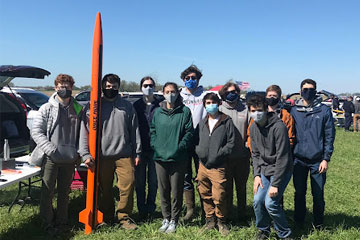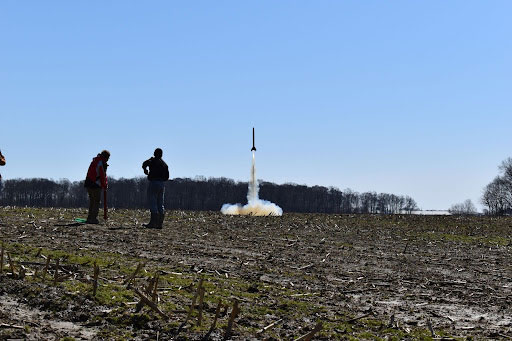
Last year, members from Case Western Reserve University’s student aerospace design team, Case Rocket Team, competed virtually in an international competition for the first time. They ended up taking home third place in their category and ninth in the overall competition.
Case Rocket Team is one of CWRU’s design teams located on the fifth floor of Sears think[box]. The highly diverse team has about 10-15 active members who are undergraduate, master’s and PhD students, as well as alumni. The team is not exclusive to aerospace and mechanical engineering—chemical engineering and computer science students also participate in team projects.
“While rockets are very aerospace centric, we have a lot of different problems at play that can tie in to most STEM majors,” Case Rocket Team President Maddie Barto noted. “In the past, the team has attended other types of competitions like Battle of the Rockets, and we spend a lot of time researching and developing technology for our rockets like sewing our own parachutes and experimenting with winding our own fiberglass tubes.”
The competition they participated in was Spaceport America Cup, which brings together rocket enthusiasts from around the world with the goal of launching a rocket 10,000 feet. While there were no launches because the competition was held virtually due to the COVID-19 pandemic, Case Rocket Team built two scale test rockets they tested multiple times; submitted their 143-page report paper; participated in a Q&A session with the judges; and they were selected for a podium presentation to talk about their RAM Air Parachute.

The lengthy report is what helped them snag third place in the competition. Fortunately, the majority of the paper involved talking about what they had worked on all year—the logistics involved to launch a rocket 10,000 feet.
“We were unable to hold many launches my freshman year as that was the beginning of the pandemic,” explained Barto. “I was worried we wouldn’t be able to build and launch as successfully with limited access and less people on campus, so it was amazing to see several test rockets come together and be launched while the majority of classes were completely remote.”
Though the competition rocket is their main focus, they also host other vital programming—such as introducing new members to rocketry and the engineering design process. And, everyone has the opportunity to design and build their own high-powered rocket.
“Once they are ready, we take everyone out to our launch site and have an awesome day of launches,” said Russel Lubin, public relations manager for the team.
To learn more about the Case Rocket Team, visit their website. To donate directly to the team to help members launch their own rocket, visit this website and put the club’s name in the designation box.
